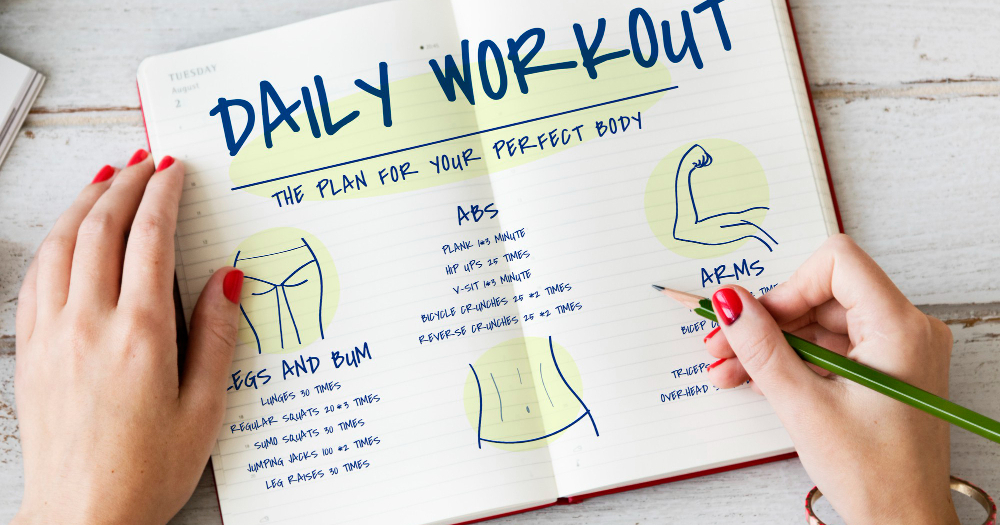{{ banner_block|raw }}
What is an exercise routine and why do you need one?
An exercise routine is a structured plan that outlines what, when, and how you train throughout the week. Whether you're trying to build muscle, lose fat, or simply move more — a solid routine brings consistency, which is the real key to results.
Without a routine, it’s easy to:
Skip workouts when life gets busy
Overtrain certain muscle groups while neglecting others
Plateau or get bored

A routine brings purpose, structure, and progression. It helps you build habits, not just momentum.
How to choose the right workout routine for your goals
Your fitness goals should shape the core of your plan:
| Goal | Focus | Weekly Frequency |
|---|---|---|
| Fat loss | Cardio + full-body strength training | 4–5x |
| Muscle gain | Progressive strength training | 4–6x |
| Improved endurance | Cardio with intervals + cross-training | 3–5x |
| General health | Moderate mix of cardio & strength | 3–4x |
Strength training, cardio, or both: Finding the right balance
Both cardio and strength training offer unique benefits — and combining them can supercharge your results:
Strength training: Builds lean muscle, improves metabolism, strengthens joints.
Cardio: Boosts heart health, stamina, mood, and aids fat loss.
For most people, a good split is:
3–4 days of strength
2–3 days of cardio
1 rest or active recovery day
How many days a week should you follow a workout routine?
It depends on your schedule, experience, and recovery needs.
Beginners: 3–4 days/week is enough
Intermediate: 4–5 days/week
Advanced: 5–6 days/week, with smart deloads
The key: Quality > quantity. You’ll make more progress with four focused, consistent sessions than with seven sporadic ones.

Best beginner-friendly workout routines to start with
Here are three tried-and-true options for newcomers:
1. 3-day full-body split
Mon: Full-body
Wed: Full-body (lighter)
Fri: Full-body (focus on form & range)
2. Upper-lower split
Mon: Upper body
Tue: Lower body
Thu: Upper body
Fri: Lower body
3. Push-pull-legs (3–6x/week)
Push: Chest, shoulders, triceps
Pull: Back, biceps
Legs: Quads, hamstrings, glutes
At-home vs. Gym-based exercise routines: Pros and Cons
| Factor | At-home workouts | Gym workouts | |
|---|---|---|---|
| Cost | Low or free | Membership required | |
| Convenience | No commute, anytime access | Dedicated space for focus | |
| Equipment | Bodyweight or minimal tools | Full range of machines and weights | |
| Motivation | May lack accountability | Energy and community can boost effort |
Tip: You can get incredible results at home with just your body, resistance bands, or a pair of dumbbells.
Sample weekly workout routine for beginners
Day | Focus |
|---|---|
| Monday | Full-body strength |
| Tuesday | Cardio (brisk walk, HIIT) |
| Wednesday | Rest or yoga/stretching |
| Thursday | Full-body strength |
| Friday | Cardio (bike, jog, dance) |
| Saturday | Optional: light mobility |
| Sunday | Rest |
How to stay consistent and adjust your routine over time
1. Set realistic goals
Don’t try to overhaul your life in a week. Start small — 3 workouts a week is great.
2. Track your progress
Use an app, journal, or calendar. Seeing wins (even small ones) builds motivation.
3. Mix it up (strategically)
Change your workouts every 4–6 weeks to avoid plateaus and boredom, but keep the core structure.

4. Don’t chase perfection
One missed workout isn’t a failure. Progress comes from consistency — not perfection.
✅ Eat well. Train regularly. Stay consistent. You’ve got this.
🎉 Ready to take the next step?
Get 70% OFF your StarFit subscription with our exclusive promo!
👉 MEDIUM
Access expert-led programs, track your progress, and build the body (and lifestyle) you deserve — all in one place.
Don’t wait — the offer won’t last forever!
















